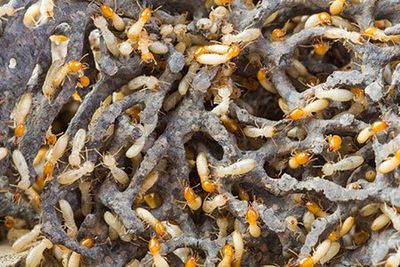Johndrow's Pest Control Inc. provides professional termite control
in Northwest Oklahoma.
In Northwest Oklahoma, there are only subterranean termites.
Termites are detritivores, consuming dead plants at any level of decomposition. They also play a vital role in the ecosystem by recycling waste material such as dead wood, fences, and plants. Unfortunately, your home is built with dead wood.
termites require moisture for survival
Termites construct shelter tubes, also known as earthen tubes or mud tubes, that start from the ground. These shelter tubes can be found on walls and other structures. Constructed by termites during the night, a time of higher humidity, these tubes protect termites from potential predators, especially ants. Shelter tubes also provide high humidity and darkness and allow workers to collect food sources that cannot be accessed in any other way. These passageways are made from soil and feces and usually are brown. The size of these shelter tubes depends on the number of available food sources. They range from less than 1 cm to several cm in width but may be dozens of meters in length. Subterranean Termites must have moisture to survive, whether it be directly from the ground or a leaking roof, leaking eves, or plumbing leaks.
The swarming season
Most worker and soldier termites are entirely blind as they do not have a pair of eyes. Consistent with all insects, the anatomy of the termites consists of three segments, each segment contains a pair of legs. The non-reproductive castes of termites are wingless and rely exclusively on their six legs for locomotion. Worker termites undertake the most labor within the colony, being responsible for foraging, food storage, and brood and nest maintenance. Workers are tasked with the digestion of cellulose in food and are thus the most likely caste to be found in infested wood. Termites only leave the colony when a nuptial flight takes place, males and females pair up together and then land in search of a suitable site for a new colony. This is commonly known as swarming. The swarming season frequently happens when barometric pressure, humidity, and temperature are adequate, usually in the spring months. In North America, there are 18 subterranean species of termites.
protecting your home from a termite infestation
Owing to their wood-eating habits, many termite species can do significant damage to unprotected buildings and other wooden structures. Termites play an essential role as decomposers of wood and vegetative material. The conflict with humans occurs where structures and landscapes containing structural wood components, cellulose derived structural elements, and ornamental vegetation provide termites with a reliable source of food and moisture.
Their habit of remaining concealed often results in their presence being undetected until the wood is severely damaged, with only a thin exterior layer of wood remaining, which protects them from the environment. Sheetrock, commonly used in homes, has a covering paper, cellulose material, which is an excellent source of food for termites.
Termite colonies are always present in the ground; what keeps your home protected from a termite infestation is the chemical barrier underneath the foundation of your home.
